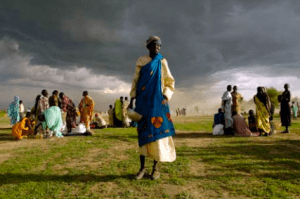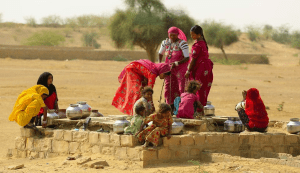
We have previously explored the connection between feminism and the environment, and this week’s lesson takes a closer look at the correlation between women in governmental seats of power and the opportunities to enact substantial, positive environmental change. In Gender Equality and State Environmentalism, Norgaard and York explain that “…ecofeminist theory asserts that sexism and environmental degradation are interconnected processes” (York, 2005, 508). When expanding upon how we address environmental issues, it is paramount that women have a voice in creating policies that not only protect the environment but also promote gender equality in parliamentary arenas. As supported by Norgaard and York’s research, the larger the amount of women who are involved in making decisions within government agencies, the more likely there is an emphasis on state environmentalism, that is, concern for the environment at a governmental level. “If women tend to be more environmentally progressive, the inclusion of women as equal members of society – as voters, citizens, policy makers, and social movement participants – should positively influence state behavior” (York, 2005, 508).
As we have looked at in previous posts, women bear a strong connection to nature and the environment. In the global South, it is women who are responsible for water collection and in many cases, for farming and food production to fee their families. One cannot do these tasks without being connected to nature and being invested in the practices that contribute to the preservation of natural resources. In both the global South and North, it’s logical to think that women should have a prominent role within government agencies to let their knowledgeable and intuitive voices be heard.
Norgaard and York looked at a variety of countries and the representation of women with regard to the overall body of government representation and the level of state environmentalism. Their findings support that there were more environmental policies, support, and advocation within countries that have more women involved than those who do not. In addition, they noted that countries with “modernization and development generally lead to greater support for environmental treaties” (York, 2005, 513). Sadly, countries who scored the lowest in their poll not only have an unequal representation of women, but also a lack of importance on environmental issues. The leaves the women of less developed countries subject to patriarchal gendered roles as well lack of opportunity to advocate for the protection and preservation of the world around them.

An organization that supports the findings of Norgaard and York is the UN Women Watch. The UN as a broader, global organization supports peace, dignity, and equality on a healthy planet, and the Women Watch takes this one step further in advocating for both gender equality and the empowerment of women. As Norgaard and York point out, “The presence of sexism (as well as poverty and racism) enables social elites, corporations, and industry to maintain an appearance of progress and success while engaging in activities that are damaging not only to individual communities but to global ecological systems as well” (York, 2005, 510). Specifically, the fact sheet on Women, Gender Equality and Climate Change points out many ways in which climate change is not gender-neutral. It further shows the abundant ways in which women are inextricably linked to the environment around them (from water collection to migration to indigenous practices involving the environment around them to environmental policies) and how their voice is integral to state environmentalism. The UN emphasizes the importance of women being involved in parliament in stating, “The consultation and participation of women in climate change initiatives must be ensured, and the role of women’s groups and networks strengthened. Currently, women are underrepresented in the decision-making process on environmental governance. They should be equally represented in decision-making structures to allow them to contribute their unique and valuable perspectives and expertise on climate change” (Women, Gender Equality and Climate Change, n.d., 7)

Another organization that supports the importance of women’s involvement in environmental policy making is The Wilson Center, a US-based, non-partisan policy forum focused on tackling global issues. In taking a closer look at the connections between gender and climate change, this article highlights the inequality amongst those able to make policies to protect the environment, and how this comes at the expense of women. “The security and climate policy communities tend to be comprised of people, mainly men, who are almost completely lacking in gender expertise or even gender policy awareness. As a result, the gender dimensions of security and climate issues are usually not understood, prioritized, integrated, or even considered in security and climate policy packages. It follows, of course, that gendered risks and dangers—affecting more than 7.8 billion people around the world—are not being adequately addressed and opportunities to more effectively respond are being overlooked” (Gender, Climate Change, and Security: Making the Connections, n.d.). In further support of Norgaard and York’s findings, it imperative that women be involved in environmental policy making as it affects them, those they care for, and the world around them.
 As for a statistic that supports Norgaard and York’s central thesis and correlates to the image to the left, I found two. “Just 26.8 % of government ministers responsible for policies on environment and climate change are women, while 73.2 % are men. Although this represents a significant gender imbalance, the proportion of women is the highest since data was first collected in 2012 (19.2 %)” (Browse Gender Statistics | Gender Statistics Database | European Institute for Gender Equality, n.d.).
As for a statistic that supports Norgaard and York’s central thesis and correlates to the image to the left, I found two. “Just 26.8 % of government ministers responsible for policies on environment and climate change are women, while 73.2 % are men. Although this represents a significant gender imbalance, the proportion of women is the highest since data was first collected in 2012 (19.2 %)” (Browse Gender Statistics | Gender Statistics Database | European Institute for Gender Equality, n.d.).
“Within the national parliaments of EU Member States, the parliamentary committees that consider policy issues and scrutinise government action in relation to environment and climate change show a similar lack of gender balance, being made up of 29.7 % women and 70.3 % men. The composition of committees in individual countries tends to reflect that of the parliament as whole, with committees in Sweden, Italy and Spain all having 40 % or more of each gender, while those in Romania, Slovenia and Malta have at least 90 % men” (Browse Gender Statistics | Gender Statistics Database | European Institute for Gender Equality, n.d.).
I invite you to think of other ways in which women are innately connected to the environment. Does your local government have any policies that support women and/or the environment? How might you be able to become more involved in the advocacy for both women in governmental bodies as well as policies that protect the local and global environment?
Browse Gender Statistics | Gender Statistics Database | European Institute for Gender Equality. (n.d.). European Institute for Gender Equality. https://eige.europa.eu/gender-statistics/dgs/data-talks/decision-making-environment-and-climate-change-women-woefully-under-represented-eu-member-states
Gender, Climate Change, and Security: Making the Connections. (n.d.). Wilson Center. https://www.wilsoncenter.org/article/gender-climate-change-and-security-making-connections
Kari, & York, R. (2005). Gender Equality and State Environmentalism. https://pages.uoregon.edu/norgaard/pdf/Gender-Equality-Norgaard-York-2005.pdf
Women, Gender Equality and Climate Change. (n.d.). unwomen.org. Retrieved March 19, 2023, from https://un.org/womenwatch/feature/climate_change/

Hey Christine,
We both used the same statistic from the European Institute for Gender Equality. It made me really happy to read that this is the highest number of women that have been involved since their last poll in 2012 but that’s still not high number. Not even a quarter of the people making these environmental decisions are women.
If you want more information on this discussion, there is a whole subcategory on their site for environmentalism. They cover various other topics as well but there are numerous articles that just discuss women and the environment.
https://eige.europa.eu/topics/environment-and-climate-change
Hi Christine!
I enjoyed reading this post, because you pointed out some really important aspects to the women and environment issue.
To be more specific, I am speaking to your second paragraph. In it, you spoke about women in the Global South and North relying on the environment around them to provide resources for the well being of their family. I agree that more women deserve to have a role within their own government in order to preserve and exercise the gifts that they provide every day for themselves and others in the community that they live in.
Since I am a natural birthing fan, this paragraph also sparked the question in my mind of how many women in the Global south use nature and the environemnt to birth their babies in. Since there are less resources for hospitals, I think that it’s also important to harness the land for the importance of birthing children naturally. I wish that I could find or remember the name of the women who I was once shown a video of, using her house bath that was kind of outside to birth her second child in… 100% naturally. It was one of the most natural and beautiful things I have ever seen, and although she was in labor, you could tell that she was so connected with the earth, and the elements outside to labor with, and then birthed in this beautiful big outside hot water filled bath. No one else but her, her husband, and her first born (excluding the camera person).
Just like women are responsible for water collection and farming, they also need to be responsible for the health of their babies. If I ever have a kid, I would definitely want it to be at home or in nature with no clinical tools in sight.
I would be interested to do more independent research on how women in different parts of the world birth naturally. In America, it can easily mean just unmedicated but still in a hospital, or at home. But in other parts of the world, women use nature more extensively.
I also liked your photos, as they are beautiful, and provide good context to the reading.
Hey Christine!
I thought that your blog post this week was really captivating and informative and the photos you included invoked a sense of community and relationship to women and nature.
At the end of the blog post this week, I really liked how you asked the reader to question their own local government and see if there’s policies that support women and/or the environment. I think that having people look at their own communities to see what needs to be changed or addressed is important. Change even on a smaller scale can incite more progressive movements for the future, even small things can help to make a larger social impact. I also thought that your reference to the UN Women Watch was complimentary and supportive of Norgaard and York’s findings. In regard to The Wilson Center you referenced, the article Gender, Climate Change, and Security: Making the Connections was powerful and interesting. The quote, “scholars have demonstrated that women are disproportionately affected by climate change due to social, economic, and political inequalities” stood out to me (Brown, Oudraat, 2022). This reminded me of the statistic I included in my blog post from the Women’s Earth Alliance, that women “make up 80% of the world’s climate refugees and are 14 times more likely to die in a climate-related disaster than men” (WEA). Women are primarily subjected to different environmental dangers and risks and therefore women should be involved in environmental policy making. The Organization of Economic Co-operation and Development recognizes and believes different gendered perspectives are important when it comes to climate change policies, now we need to prioritize the inclusion of different genders for more sustainable policies and gender equality.
Hi Christine! Both of us made the premise that environmentalism and the effects of environment degradation is not gender neutral. As I pointed out in my blog that the lack of gender neutrality is not just on the basis of getting and maintaining resources in a crumbling environment, it also has the do with accessibility of healthcare and what environmental degradation does to women’s health with the release of toxic chemicals into communities, particularly lower income communities. Norgaard and York state that “as in the case of young girls are employed in dangerous situations in factories because they are seen as passive and less likely to organize or when toxic materials are produced and disposed of in poor communities.” I believe that premise goes to show to ecofeminism is very intersectional. And on the other hand shows that environmental degradation is also intersection. In the example given about with the young girls in factories, we have three separate identities that are effected by environmental degradation – female, young and poor. I say this to expand on the need for women in government especially when it comes to the environment. When it comes to women government it is very important to acknowledge that we need representation across different identities. It is not enough that we have women in government, government needs to look like the country it represents. And this means different ages, races, and socioeconomic statuses, not just looking at the amount males versus the amount of females.